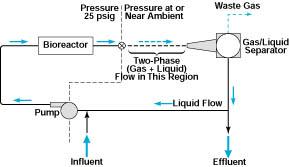A pressure-swing technique has been developed for controlling the generation and flow of gas in an anaerobic biological reactor and associated equipment in a system that processes wastewater. The purpose and effect of the technique is to prevent the formation of gas bubbles in the reactor; if allowed to coalesce in the reactor, gas bubbles could impede the flow of the liquid stream, rendering the treatment system less effective. The technique was conceived for application to a wastewater treatment system that would operate in microgravity, but could also be applied to bioreactor systems (e.g., fermentation systems) that operate in Earth-normal gravity.

A representative system that implements the present technique (see figure) includes a packed-bed reactor that is inoculated with anaerobic micro-organisms, a gas/liquid separator, a pump, a back-pressure relief valve, and associated plumbing and other hardware. Wastewater is fed into the system at a constant rate, and effluent is removed from the system at the same rate, both at a pressure near ambient. The pump pressurizes the water to 25 psig (gauge pressure of 172 kPa) and circulates the water through the bioreactor at a rate of 20 times the influent/effluent rate. After passing through the reactor, the water flows through the back-pressure relief valve and is thereby depressurized to near ambient pressure.
In the reactor, the pressure is high enough to keep all gases in solution; this includes gaseous waste products generated by micro-organisms through their metabolism of contaminants in the wastewater. The depressurization causes the gaseous waste products generated in the reactor to evolve into gas bubbles. The resulting two-phase mixture flows into a gas/liquid separator. The separated gases are vented to the atmosphere, and the separated liquid travels to the pump, where it is repressurized for the next pass through the reactor.
The design size of the reactor is based on the desired rate of flow and the anticipated daily contaminant loading of the wastewater to be treated. The reactor pressure and the ratio between the recirculating flow and the inlet or outlet flow could differ from the values stated above; for a given application, they are calculated to maintain gases in solution in the bioreactor. In general, the use of a higher pressure makes it possible to reduce the liquid recirculation rate.
This work was done by Karen D. Pickering and Eugene K. Ungar of Johnson Space Center. For further information, access the Technical Support Package (TSP) free on-line at www.nasatech.com/tsp under the Machinery & Automation category.
MSC-22987

